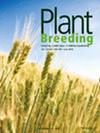Exploring Plant Diversity Through Enzyme‐Mediated Analysis Using Electro‐Carbon Sensors
IF 1.8
4区 农林科学
Q2 AGRONOMY
引用次数: 0
Abstract
This review explores the application of enzyme‐mediated analysis using electro‐carbon sensors to investigate plant diversity. Precision plant genotype fingerprinting (PPGF) represents a paradigm shift in agricultural science, merging the fields of phyto‐enzyme identification and quantification with cutting‐edge electro‐sensor technology. PPGF acts as a powerful tool for dissecting the genetic makeup of plant species by meticulously examining their unique phyto‐enzyme signatures. Electro‐sensor technology emerges as a pioneering force, utilizing electro‐analytical methods to precisely measure and differentiate these markers. Enzyme‐based sensors are capable of detecting plant metabolites even at low concentrations, enabling highly precise and accurate measurements. Furthermore, they are generally more eco‐friendly because they use fewer hazardous chemicals and produce less waste. These sensors can function under gentle conditions and can be miniaturized, making them highly suitable for field applications. This synergistic approach between PPGF and electro‐sensor technology ushers in a transformative era, offering unprecedented insights into plant genomics and paving the way for novel avenues for PPGF. Overall, enzyme‐based electrochemical sensors contribute to improving the efficiency and effectiveness of plant fingerprinting, thereby facilitating more comprehensive and precise plant phenotyping and research endeavours.利用电碳传感器通过酶促分析探索植物多样性
本综述探讨了利用电碳传感器进行酶介导分析以研究植物多样性的应用。精准植物基因型指纹图谱(PPGF)代表了农业科学的范式转变,它将植物酶鉴定和定量领域与尖端的电传感器技术融为一体。PPGF 是一种强大的工具,可通过仔细检查植物物种独特的植物酶特征来剖析其基因构成。电传感器技术是利用电分析方法精确测量和区分这些标记的先驱。基于酶的传感器即使在浓度很低的情况下也能检测植物代谢物,从而实现高度精确和准确的测量。此外,由于使用的有害化学物质较少,产生的废物也较少,它们通常更加环保。这些传感器可以在温和的条件下工作,而且可以小型化,因此非常适合野外应用。PPGF 与电传感器技术之间的这种协同方法开创了一个变革时代,为植物基因组学提供了前所未有的见解,并为 PPGF 的新途径铺平了道路。总之,基于酶的电化学传感器有助于提高植物指纹识别的效率和效果,从而促进更全面、更精确的植物表型分析和研究工作。
本文章由计算机程序翻译,如有差异,请以英文原文为准。
求助全文
约1分钟内获得全文
求助全文
来源期刊

Plant Breeding
农林科学-农艺学
CiteScore
4.40
自引率
5.00%
发文量
74
审稿时长
3.0 months
期刊介绍:
PLANT BREEDING publishes full-length original manuscripts and review articles on all aspects of plant improvement, breeding methodologies, and genetics to include qualitative and quantitative inheritance and genomics of major crop species. PLANT BREEDING provides readers with cutting-edge information on use of molecular techniques and genomics as they relate to improving gain from selection. Since its subject matter embraces all aspects of crop improvement, its content is sought after by both industry and academia. Fields of interest: Genetics of cultivated plants as well as research in practical plant breeding.
 求助内容:
求助内容: 应助结果提醒方式:
应助结果提醒方式:


